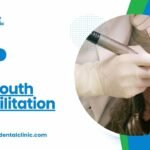Understanding Dental Restorations: Dental Bridges, Crowns and Fillings
Oral health plays a significant role in our overall well-being. From our ability to eat and speak comfortably to our confidence in flashing a bright smile, the condition of our teeth and gums is essential. Unfortunately, many of us experience oral health issues at some point in our lives, such as cavities, gum disease, or tooth loss. The good news is that restorative dentistry offers a range of treatments to address these concerns and help us regain our oral health. In this comprehensive guide, we will explore the world of restorative dentistry, explaining what it is, the various procedures involved, and how it can transform your smile and quality of life.
Understanding Restorative Dentistry
Restorative dentistry is a branch of dentistry that focuses on repairing and replacing damaged or missing teeth and restoring the overall functionality and aesthetics of your smile. This field is dedicated to improving oral health, which, in turn, has a positive impact on your overall well-being. Restorative dentists work to rehabilitate your teeth and gums, ensuring that you can eat, speak, and smile with confidence.
Common Oral Health Issues
Before we delve into the world of restorative dentistry, it’s essential to understand the common oral health issues that can affect anyone. Some of the most prevalent problems include:
- Cavities: Cavities, also known as dental caries, are small holes that develop in the teeth due to tooth decay. They often result from poor oral hygiene and a diet high in sugary and acidic foods.
- Gum Disease: Gum disease, or periodontal disease, is an infection of the gums and supporting structures of the teeth. It can range from mild gingivitis to severe periodontitis if left untreated.
- Tooth Loss: Tooth loss can occur due to various reasons, such as trauma, decay, or gum disease. Missing teeth can impact your oral health and self-esteem.
Restorative Dentistry Procedures- Dental Bridges Crowns and Fillings
Restorative dentistry offers an array of procedures to address these common oral health issues. Here are some of the most commonly used techniques:
- Dental Fillings: Dental fillings are used to repair cavities. They involve removing the decayed portion of the tooth and filling the space with materials like composite resin, amalgam, or porcelain.
- Crowns and Bridges: Crowns are custom-made caps placed over a damaged tooth to restore its shape and strength. Bridges are used to replace missing teeth by anchoring them to adjacent healthy teeth.
- Dentures: Dentures are removable appliances that replace missing teeth and their surrounding tissues. They come in full and partial forms, depending on your needs.
- Dental Implants: Dental implants are artificial tooth roots surgically implanted into the jawbone to support dental crowns, bridges, or dentures. They provide a strong and permanent solution for tooth loss.
- Root Canal Therapy: Root canal therapy is performed to save a severely damaged or infected tooth. The procedure involves removing the infected pulp and sealing the tooth.
- Periodontal Treatments: For gum disease, restorative dentists provide various treatments like scaling and root planing, laser therapy, and surgical procedures to restore gum health.
The Benefits of Restorative Dentistry
Restorative dentistry offers a plethora of benefits beyond just fixing teeth. These advantages encompass both oral and overall health:
- Improved Oral Function: Restorative procedures can restore proper chewing and speaking function, ensuring you can enjoy your favorite foods and communicate with confidence.
- Enhanced Aesthetics: Restorative dentistry can transform your smile, boosting self-esteem and confidence.
- Pain Relief: Procedures like root canal therapy can alleviate toothache and discomfort caused by oral health issues.
- Preventing Further Damage: Restorative dentistry can halt the progression of oral health problems, preventing more extensive and costly treatments down the road.
- Long-Term Solutions: Many restorative procedures offer long-lasting results, providing a reliable solution for your dental concerns.
- Better Overall Health: By addressing oral health issues, restorative dentistry can have a positive impact on your overall well-being, reducing the risk of systemic health problems related to gum disease.
What to Expect During Restorative Dental Procedures
If you’re considering restorative dental treatment, it’s essential to understand what to expect during the process. Here’s a general overview of what you might encounter:
- Consultation: Your first step will typically involve a consultation with a restorative dentist. They will examine your oral health, discuss your concerns, and propose a treatment plan tailored to your needs.
- Preparing for the Procedure: Depending on the specific procedure, you may need to prepare by following certain guidelines, such as fasting before surgery or taking prescribed medications.
- The Procedure: During the procedure, the dentist will use local anesthesia to numb the area, ensuring you feel minimal discomfort. They will then perform the necessary dental work, which can vary from filling a cavity to placing a dental implant.
- Recovery: After the procedure, you may experience some discomfort or swelling. The dentist will provide post-operative care instructions and schedule follow-up appointments as needed.
- Follow-Up Visits: Regular follow-up visits are essential to monitor your progress and make any necessary adjustments.
Restorative Dentistry Myths and Facts
Restorative dentistry is often surrounded by myths and misconceptions. Let’s debunk some of the most common ones:
Myth: Restorative dentistry is only for cosmetic purposes. Fact: While aesthetics are a part of restorative dentistry, its primary goal is to improve oral health, functionality, and overall well-being.
Myth: Restorative procedures are painful. Fact: Dentists use local anesthesia to ensure that you are comfortable during the procedure. Discomfort is typically minimal and manageable.
Myth: Restorative dentistry is expensive. Fact: Restorative dentistry can be an investment in your health. Many dental offices offer financing options, and the long-term benefits often outweigh the costs.
Myth: Restorative dentistry is only for the elderly. Fact: Restorative procedures can benefit people of all ages, from children with cavities to adults with missing teeth.
Myth: Restorative dentistry is a one-size-fits-all solution. Fact: Restorative dentistry is highly individualized, with treatment plans tailored to each patient’s unique needs.
Maintaining Oral Health After Restorative Procedures
After undergoing restorative dental procedures, it’s crucial to maintain your oral health to ensure the longevity of the treatments. Here are some tips to help you keep your smile in top condition:
- Oral Hygiene: Continue to practice good oral hygiene by brushing, flossing, and using mouthwash regularly.
- Regular Dental Checkups: Schedule routine dental checkups to monitor your oral health and catch any issues early.
- Diet and Nutrition: Maintain a balanced diet that is low in sugary and acidic foods, as they can contribute to cavities and gum disease.
- Avoid Harmful Habits: Quit smoking and limit your consumption of alcohol, as these habits can harm your oral health.
- Protect Your Teeth: If you participate in contact sports, wear a mouthguard to protect your teeth from injury.
What is the cost of Dental Crowns?
The cost of a dental crown can vary depending on several factors, including the type of crown, the location of the dental practice, and any additional procedures that may be required. On average, you can expect to pay anywhere from $800 to $2,500 per crown in the United States. Here’s a breakdown of some of the factors that can influence the cost:
- Type of Crown: Different types of crowns, such as porcelain-fused-to-metal, all-ceramic, zirconia, or gold crowns, have varying costs. All-ceramic and zirconia crowns tend to be more expensive due to their aesthetics and durability.
- Geographic Location: The cost of dental procedures can significantly vary by region and city. Dental care tends to be more expensive in urban areas and regions with a higher cost of living.
- Dental Provider: The experience and expertise of the dentist or dental specialist performing the procedure can affect the cost. More experienced professionals may charge higher fees.
- Additional Procedures: Sometimes, additional procedures like root canals, gum treatments, or tooth extractions may be required before placing a crown. These procedures can add to the overall cost.
- Dental Insurance: If you have dental insurance, it may cover a portion of the cost of a dental crown, reducing your out-of-pocket expenses. Be sure to check with your insurance provider to understand your coverage.
- Materials Used: The quality of materials used can impact the cost. Higher-quality materials often come at a higher price.
- Laboratory Fees: Dental crowns are custom-made in a dental laboratory, and the associated laboratory fees can affect the total cost.
To get an accurate estimate for the cost of a dental crown, it’s essential to consult with a local dentist or prosthodontist. They can assess your specific needs, discuss material options, and provide you with a detailed cost estimate based on your individual case. Keep in mind that maintaining good oral hygiene and addressing dental issues promptly can help prevent the need for extensive dental work, potentially reducing costs in the long run.
Conclusion
Restorative dentistry is a vital field that can significantly impact your oral health and overall well-being. By understanding the common oral health issues, the various procedures available, the benefits of restorative dentistry, and what to expect during treatment, you can make informed decisions about your oral health.
Remember, restorative dentistry is not just about fixing teeth; it’s about restoring your confidence, comfort, and quality of life. If you’re experiencing oral health issues, consult with a qualified restorative dentist to discuss your options and embark on a journey towards a healthier, happier smile. Your oral health matters, and restorative dentistry can help you achieve the smile you deserve.
Read Also:
Crown and Bridge Restorations.
Composite Fillings vs Amalgam Fillings.
Managing Dental Anxiety in Children.
Fluoride Treatments and Dental Sealants: Against Tooth Decay in Kids.
Treating Gum Disease with Laser Therapy.
Precision and Accuracy in Laser Dentistry.
11 things an adult can do to maintain good oral health.




